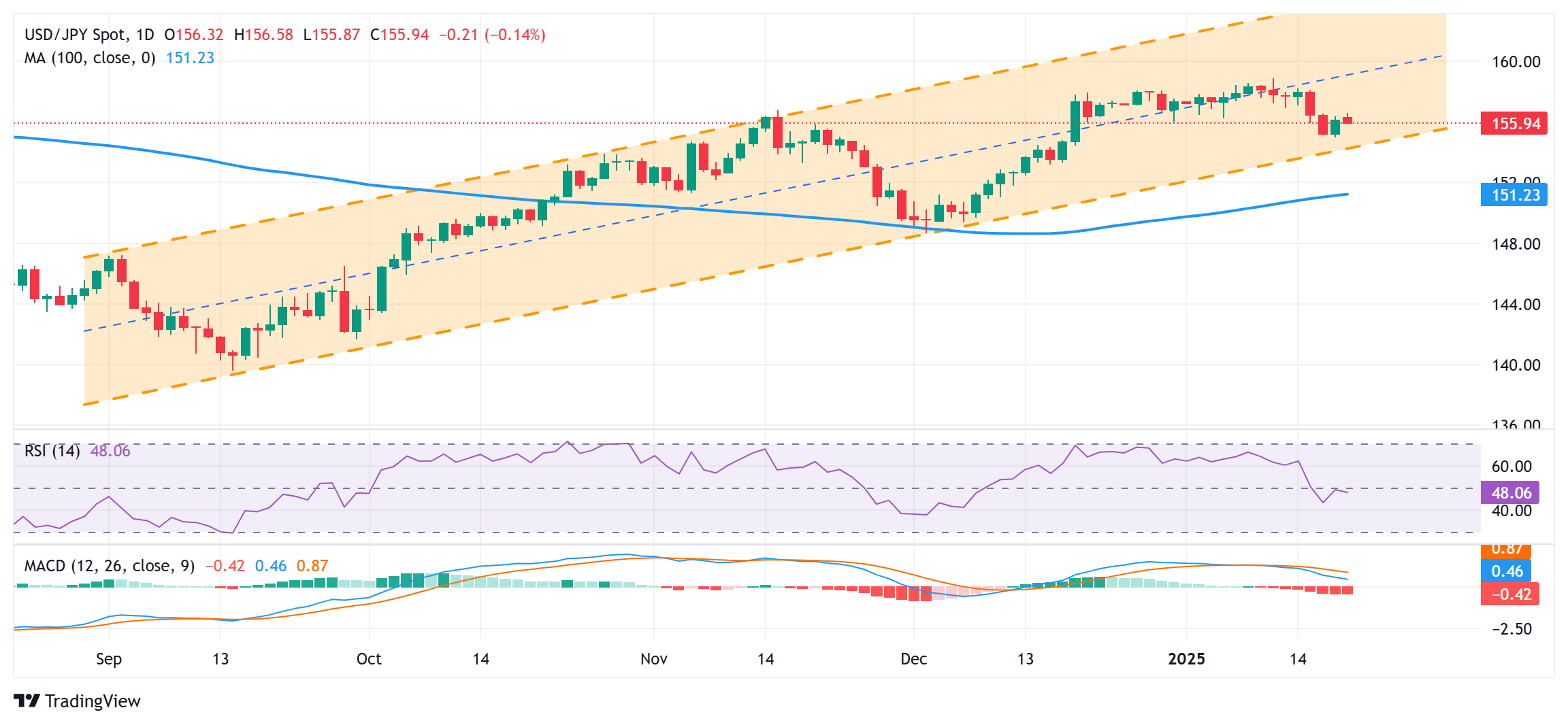- The Japanese Yen strengthens in reaction to the upbeat Core Machinery Orders data.
- Firming expectations for an additional BoJ rate hike this week also underpin the JPY.
- A modest USD downtick further contributes to the USD/JPY pair’s intraday decline.
The Japanese Yen (JPY) attracts some dip-buyers following the release of the upbeat Core Machinery Orders data from Japan and reverses a part of Friday’s retracement slide from a multi-week top against its American counterpart. Furthermore, bets that the Bank of Japan (BoJ) will hike interest rates at its policy meeting later this week underpin the JPY. This, along with a modest US Dollar (USD) downtick, drags the USD/JPY pair further below the 156.00 mark during the Asian session on Monday.
That said, uncertainties over the incoming US President Donald Trump’s trade policies and a generally positive risk tone might hold back traders from placing fresh bullish bets around the safe-haven JPY. Moreover, expectations that Trump’s protectionist policies could boost inflation and force the Federal Reserve (Fed) to stick to its hawkish stance should limit the USD losses. Traders might also opt to move to the sidelines ahead of Trump’s inaugural address later today and the BoJ meeting starting on Thursday.
Japanese Yen bulls have the upper hand as upbeat data from Japan reaffirmes BoJ rate hike bets
- Government data released earlier this Monday showed that Japan’s Core Machinery Orders increased by 3.4% month-on-month in November 2024, marking the second consecutive month of increase and the strongest growth in nine months.
- This comes on top of the broadening inflation and strong wage growth in Japan, which, along with hawkish remarks from Bank of Japan officials, lifted bets for another rate hike later this week and offered some support to the Japanese Yen.
- BoJ Deputy Governor Ryozo Himino said last week that a rate hike will be discussed at the January 23-24 meeting as prospects of sustained wage gains heighten and the US policy outlook under President-elect Donald Trump becomes clearer.
- Moreover, BoJ Governor Kazuo Ueda said last week that there was a lot of positive talk on the wage outlook and reiterated that the central bank would raise the policy rate further this year if economic and price conditions continue to improve.
- Adding to this, a BoJ report released earlier this month showed that wage hikes are spreading to firms of all sizes and sectors in Japan, suggesting that conditions for a near-term interest rate hike were continuing to fall into place.
- The JPY bulls, however, might refrain from placing aggressive bets and opt to move to the sidelines ahead of US President-elect Donald Trump’s inaugural address later this Monday and a two-day BoJ meeting starting Thursday.
- Data released last week suggested that the underlying inflation in the US slowed last month and fueled speculations that the Federal Reserve may not necessarily exclude the possibility of cutting interest rates further in 2025.
- Furthermore, Fed Governor Christopher Waller said last Thursday that inflation is likely to continue to ease and that as many as three or four quarter-percentage-point rate reductions could still be possible by the end of this year.
- The US Commerce Department’s Census Bureau reported on Friday that Housing Starts rose 3.3% in December, to a seasonally adjusted annual rate of 1.50 million units, marking the highest level since February 2024.
- This, to a larger extent, offsets a slight disappointment from the latest report on Building Permits, which registered a sudden drop of 0.7% in December as compared to the 5.2% strong growth registered in the previous month.
- The yield on the benchmark 10-year US government bond rebounded after touching a two-week low on Friday, which assisted the US Dollar to snap a four-day losing streak and offered support to the USD/JPY pair.
USD/JPY bears could aim to challenge multi-month-old ascending channel support near the 155.25 area
From a technical perspective, Friday’s bounce from support marked by the lower boundary of a multi-month-old ascending channel falters near the 156.55-156.60 region. The said area should now act as an immediate hurdle, above which a fresh bout of a short-covering could allow the USD/JPY pair to reclaim the 157.00 round figure. The subsequent move up could extend further towards the 157.40-157.45 intermediate barrier en route to the 158.00 mark and the 158.85 region, or a multi-month top touched on January 10.
On the flip side, the ascending channel support, currently pegged near the 155.25 area, might continue to protect the immediate downside ahead of the 155.00 psychological mark. A sustained break and acceptance below the latter will be seen as a fresh trigger for bearish traders and drag the USD/JPY pair towards the 154.60-154.55 region. Spot prices could extend the downward trajectory further towards the 154.00 mark en route to the next relevant support near the 153.35-153.30 horizontal zone.
Bank of Japan FAQs
The Bank of Japan (BoJ) is the Japanese central bank, which sets monetary policy in the country. Its mandate is to issue banknotes and carry out currency and monetary control to ensure price stability, which means an inflation target of around 2%.
The Bank of Japan embarked in an ultra-loose monetary policy in 2013 in order to stimulate the economy and fuel inflation amid a low-inflationary environment. The bank’s policy is based on Quantitative and Qualitative Easing (QQE), or printing notes to buy assets such as government or corporate bonds to provide liquidity. In 2016, the bank doubled down on its strategy and further loosened policy by first introducing negative interest rates and then directly controlling the yield of its 10-year government bonds. In March 2024, the BoJ lifted interest rates, effectively retreating from the ultra-loose monetary policy stance.
The Bank’s massive stimulus caused the Yen to depreciate against its main currency peers. This process exacerbated in 2022 and 2023 due to an increasing policy divergence between the Bank of Japan and other main central banks, which opted to increase interest rates sharply to fight decades-high levels of inflation. The BoJ’s policy led to a widening differential with other currencies, dragging down the value of the Yen. This trend partly reversed in 2024, when the BoJ decided to abandon its ultra-loose policy stance.
A weaker Yen and the spike in global energy prices led to an increase in Japanese inflation, which exceeded the BoJ’s 2% target. The prospect of rising salaries in the country – a key element fuelling inflation – also contributed to the move.

